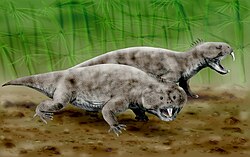| Lossiemouth Sandstone | |
|---|---|
| Stratigraphic range: Carnian–Rhaetian ~ | |
| Type | Geological formation |
| Unit of | New Red Sandstone Supergroup |
| Underlies | Stotfield Cherty Rock Formation |
| Overlies | Burghead Sandstone Formation or unconformably on Devonian beds |
| Thickness | up to 30 m (98 ft) |
| Lithology | |
| Primary | Sandstone |
| Location | |
| Coordinates | 57°42′N3°18′W / 57.7°N 3.3°W |
| Approximate paleocoordinates | 34°00′N0°54′W / 34.0°N 0.9°W |
| Region | Moray Firth |
| Country | Scotland |
| Type section | |
| Named for | Lossiemouth |
The Lossiemouth Sandstone is a Middle to Late Triassic (Ladinian to Norian) age geological formation. It is exposed on the south side of the Moray Firth near Lossiemouth and near Golspie in Sutherland. [1] Dinosaur remains are among the fossils that have been recovered from the formation. [2]









